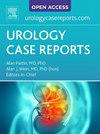Non-functional oncocytic adrenocortical carcinoma: Case report with clinicopathologic and surgical correlation
IF 0.4
Q4 UROLOGY & NEPHROLOGY
引用次数: 0
Abstract
Oncocytic adrenocortical carcinoma (OACC) is a rare variant of adrenocortical carcinoma composed predominantly of oncocytic cells. We present the case of a 45-year-old female with a large, non-functional left adrenal mass diagnosed as OACC. Imaging revealed a well-defined, vascular, heterogeneously enhancing mass without metastasis. Histopathology showed oncocytic cells disposed in nests and sheets with capsular and venous invasion, with low mitotic activity. Surgical excision was curative, and the patient remains disease-free at 10 months. This case highlights the diagnostic and prognostic utility of histologic scoring systems and underlines the role of surgery as the primary treatment in localized OACC.
无功能嗜瘤细胞性肾上腺皮质癌:1例与临床病理及手术相关
嗜瘤细胞性肾上腺皮质癌(OACC)是一种罕见的肾上腺皮质癌,主要由嗜瘤细胞组成。我们提出的情况下,45岁的女性与一个大的,无功能的左肾上腺肿块诊断为OACC。影像学显示一个界限清楚、血管性、异质性强化的肿块,无转移。组织病理学显示癌细胞呈巢状和片状分布,呈囊状和静脉浸润,有丝分裂活性低。手术切除治愈,患者在10个月后仍然无病。本病例强调了组织学评分系统的诊断和预后效用,并强调了手术作为局限性OACC的主要治疗方法的作用。
本文章由计算机程序翻译,如有差异,请以英文原文为准。
求助全文
约1分钟内获得全文
求助全文

 求助内容:
求助内容: 应助结果提醒方式:
应助结果提醒方式:


